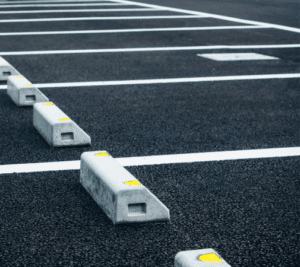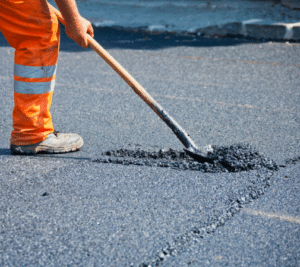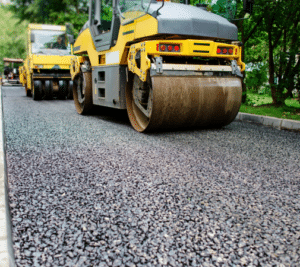There are many ways to improve the longevity and quality of a section of pavement. Many believe it is simpler to raze the pavement and repour it, but it is costly and even more time-consuming. Micro-surfacing, on the other hand, when done right, is quick, clean, and cost-effective.
If you have pavement that needs some upkeep and a little TLC, you have probably heard about micro surfacing but know little about it. How much does it cost? What is micro surfacing? Is it the best choice for me? We will give you the inside scoop on your biggest concerns when considering micro surfacing.
What is Micro Surfacing?
Pavement is constantly attacked by the elements. Micro-surfacing is a thin surface wear treatment. It is intended to fix pavement deficiencies by laying a mixture of mineral fillers, polymer additives, water, asphalt emulsion, and dense-graded aggregate as a topcoat and gap fill. This extends the life of your pavement by adding a protective coat that will not only repair the current damage but also prevent future damage.
The advantages of this preventative preservation of your pavement are many, including improving the pavement’s lifespan. Micro-surfacing can increase pavement life for up to an additional 45 years. This is attributed to the process of micro surfacing that repairs cracks, implements minor patching, and weather protects the pavement against intense heat and cold.
How Long Does Micro Surfacing Take to Dry?
One of the reasons that micro surfacing is the top choice for improving and repairing major roadways is in the drying time. Traditionally, a single coat is applied, left to dry, then a second coat is done a week later. And the drying time is between 2 and 4 hours, depending on the environment. More humid climates take longer, while dryer climates take less.
However, sometimes roadways are given a certain leeway to keep congestion to a minimum and will open within an hour of the initial coating. This is a quick fix and in no way will last as well as the double coat option, but it is the choice for crews in areas of high traffic flow. The downside of this expeditious decision is that the crew will have to return quickly to spray a second coat. It is better to wait and do it right.
How much does Micro Surfacing Cost?
The pricing will vary based on the surface getting the treatment, but the base price is around $2.75 a square foot. On a highway, it comes out to about $10,000 a mile. Again, there are variables, and this is the baseline metric for pricing. The price will be much higher if you have a four-lane highway versus a two-lane country road.
It is less costly than a slurry seal and has lower durability. The recommendation when ordering micro surfacing is only to use it to repair low-traffic areas. The cost represents the quality of the bond micro surfacing makes with the pavement.
How Often Does Micro surfacing Last?
Typically, micro surfacing will last between 5 and 7 years when done correctly. There have been reports of it lasting up to 10 and longer, but those instances are rare, and the conditions have to be ideal. For example, a heavily cracked road versus one that is almost new and is getting a preventative coating to extend its life will have different lifespans.
To get the best results, always hire a professional paving contractor that has experience with micro surfacing the type of pavement you want to be protected. While an unlicensed person can do it with minimal training, the only way to guarantee the quality and longevity of the micro surfacing is when a licensed pro does it.
What is the Difference Between Micro Surfacing and Slurry Seal?
The most significant differences between a slurry seal and micro surfacing are in the materials. Micro-surfacing uses a polymer-modified asphalt emulsion, whereas a slurry seal is comprised of a standard asphalt emulsion. Micro-surfacing induces a chemical reaction that forces moisture out of the pavement, while a slurry seal needs the water to evaporate naturally.
Because of the chemical nature of micro surfacing and the quick reaction time of moisture removal, the pavement can be ready for traffic in about an hour. In contrast, slurry-sealed pavement needs several hours to set. The biggest difference is that a slurry seal is best for repairing already damaged pavement, while micro surfacing is designed to protect pavement, so it doesn’t get damaged.
What Are the Advantages of Micro-surfacing?
We have already touched on the quick dry time and cost-effectiveness of micro surfacing, but this preventative coating choice has plenty of other upsides. For instance:
- Micro-surfacing adds a layer of grit to the road surface, providing better traction for motorists. It increases surface friction and allows vehicles to grab the pavement more effectively in most environmental conditions.
- It makes the roads look better. We have all seen the difference between terribly damaged roadways and well-maintained pavement.
- Extending of pavement life. This circles back to being not only cost-effective but also the quality of the pavement overall.
- Sealing of surfaces. An effective seal prevents water from infiltrating the pavement bed, breaking it down below the surface, and causing erosion. It also minimizes oxidation, another factor in pavement breakdown.
- It’s the green solution. In most cases, micro-surfacing is done with environmentally neutral materials, limiting greenhouse gases and lowering overall energy consumption.
Conclusion
When choosing a pavement seal for your needs, consider the quick and effective micro surfacing option. It might seem silly at first to pour new pavement and then seal it for what might happen over time, but in many walks of life, we do the same thing to protect what we own, such as scotch guarding furniture to prevent stains from spills or buying a warranty on your appliances. Take care of your pavement, and it will take care of you.



